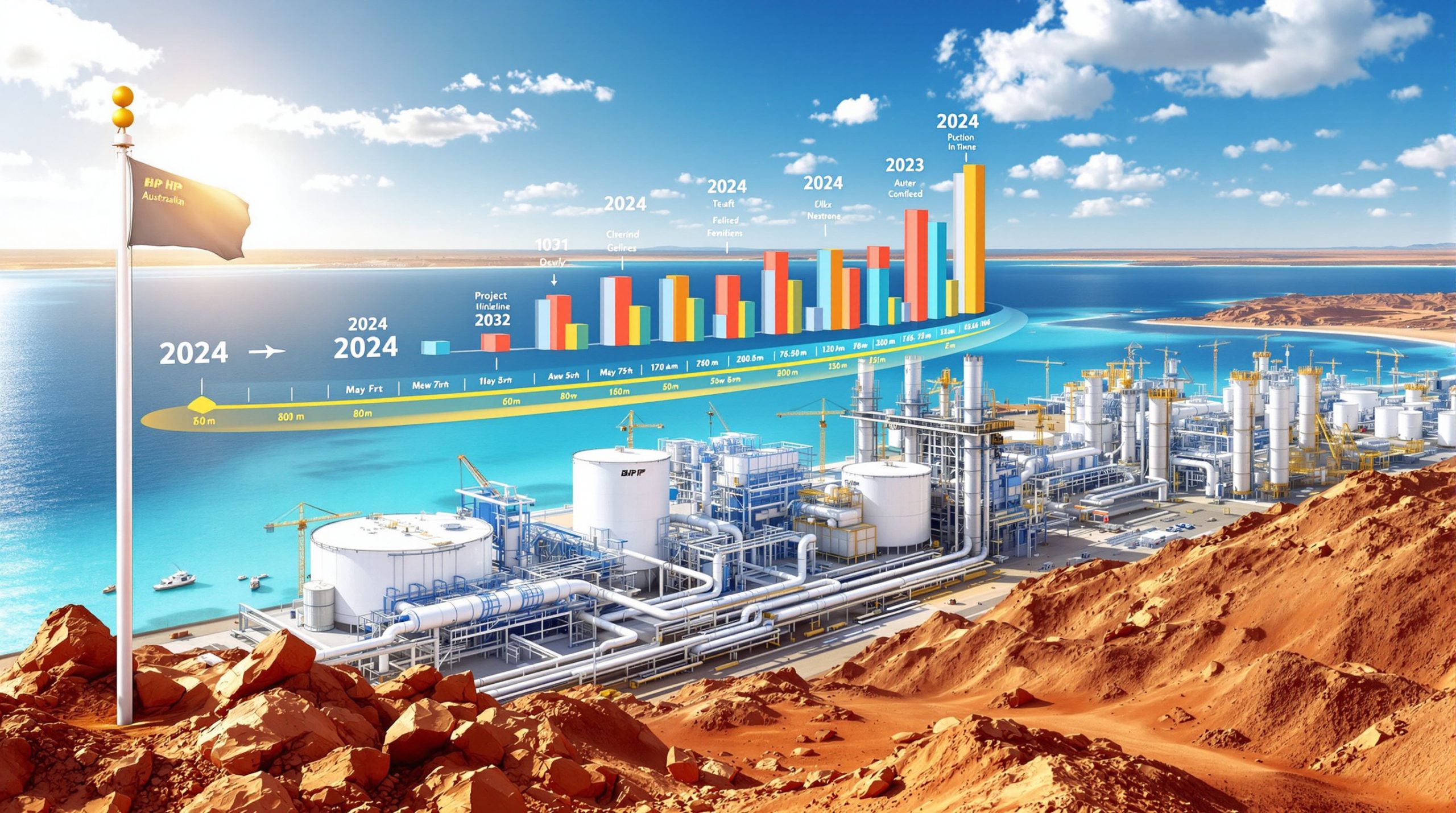Fortescue's Strategic Pivot: Record Iron Ore Performance Amid Green Energy Project Cancellations
Fortescue, one of Australia's mining giants, has achieved remarkable success in its core iron ore business while simultaneously making significant changes to its green energy strategy. The company has posted record-breaking production figures while canceling key renewable energy projects in a move that signals a potential realignment of its long-term vision.
How is Fortescue's iron ore business performing in 2025?
Fortescue has demonstrated exceptional operational excellence in its traditional mining business, with production figures that have exceeded both historical benchmarks and market expectations. The company's iron ore division continues to be the bedrock of its financial strength, providing substantial cash flow even as the organization navigates strategic shifts in its diversification efforts.
Record-Breaking Quarterly Performance
Fortescue's fourth-quarter iron ore shipments reached an impressive 55.2 million metric tons (Mt), representing a 2.8% year-over-year increase from 53.7 Mt in the same period of fiscal year 2024. This performance significantly exceeded market expectations, with analysts at Visible Alpha having estimated shipments of approximately 52.5 Mt – a difference of 5.1%.
The company's ability to surpass expectations has been attributed to enhanced processing capabilities for its steel-making commodity, though specific technological improvements haven't been detailed in public disclosures.
Annual Production Milestone
For the full fiscal year 2025, Fortescue's total iron ore shipments reached 198.4 Mt, establishing a new company record for annual production. This achievement solidifies Fortescue's position as a major player in the global iron ore price trends market, though still behind industry leaders Rio Tinto (336 Mt) and BHP (285 Mt) based on their 2024 production figures.
This exceptional performance has positioned Fortescue at the upper range of its annual guidance targets, demonstrating the company's ability to deliver consistently on its core business objectives despite broader market volatility and internal strategic shifts.
Why is Fortescue canceling green energy projects?
Following a comprehensive strategic review, Fortescue has made the significant decision to discontinue two major green energy initiatives. This represents a notable shift in the company's diversification strategy that had been championed by billionaire founder and chairman Andrew Forrest.
Terminated Green Energy Projects
The company has officially canceled two high-profile projects:
- The Arizona hydrogen project in the United States, which focused on large-scale hydrogen production
- The PEM50 project in Gladstone, Australia, which involved proton exchange membrane electrolyser technology
Gladstone had been strategically selected for its access to renewable energy transformations and port infrastructure, making it an ideal location for green hydrogen production and export. Similarly, the Arizona project had been positioned to capitalize on the growing U.S. hydrogen market.
According to Mining.com, "Fortescue is assessing options to repurpose the land and assets" associated with these canceled projects, suggesting the company is seeking to minimize sunk costs and potentially pivot these resources toward more viable ventures.
Financial Implications of Project Cancellations
The financial impact of these cancellations is substantial but manageable within Fortescue's overall financial position. The company has announced a preliminary pre-tax writedown estimated at approximately $150 million, which will be reflected in its second-half 2025 financial results.
This writedown encompasses:
- Development expenses for the PEM50 project
- Costs associated with electrolyser manufacturing equipment in Gladstone
- Engineering expenses for the Arizona hydrogen project
While $150 million represents a significant sum, it's relatively modest compared to Fortescue's overall revenue from its iron ore business, which generated $12.7 billion in fiscal year 2024 according to the company's annual report.
What factors influenced Fortescue's decision to abandon these green initiatives?
While Fortescue hasn't explicitly detailed all the factors behind its decision to cancel these projects, several market and economic realities likely played a decisive role. The timing of these cancellations coincides with broader challenges facing the green hydrogen industry globally.
Market Challenges for Green Hydrogen
The global market for green hydrogen has faced significant headwinds in recent years. According to International Energy Agency data, global green hydrogen demand fell approximately 15% year-over-year in 2024, creating challenging conditions for new projects.
A primary obstacle has been the persistent cost differential between green hydrogen and conventional alternatives. Green hydrogen production costs remain around $4.50 per kilogram, compared to approximately $2.00 per kilogram for "gray" hydrogen produced from natural gas without carbon capture (BloombergNEF, 2025). This significant cost premium makes green hydrogen economically challenging without substantial government subsidies or carbon pricing mechanisms.
As noted by Fortescue Energy's CEO, "Green hydrogen cost is key as demand drops," highlighting the fundamental economic challenge facing these projects.
Strategic Refocusing
The cancellations may also represent a strategic refocusing on Fortescue's part, potentially driven by:
- Shareholder pressure to maximize returns from the highly profitable iron ore business
- A more measured approach to green energy investments, focusing on projects with clearer paths to profitability
- Reallocation of capital to core operations or more promising diversification opportunities
- A response to changing market conditions and economic outlooks
It's worth noting that while Fortescue is stepping back from these specific projects, the company has not abandoned its green energy ambitions entirely, suggesting a recalibration rather than a complete strategy reversal.
How does this decision impact Fortescue's future direction?
This strategic pivot raises important questions about Fortescue's long-term vision and how the company plans to balance its traditional mining operations with its previously stated green energy ambitions. The decision signals a potential rebalancing of priorities but doesn't necessarily indicate a complete abandonment of sustainability goals.
Balancing Tradition and Innovation
Fortescue now faces the challenge of communicating a coherent vision that reconciles its continued excellence in iron ore production with its revised approach to green energy. The company must articulate:
- How it will maintain its commitment to sustainability while prioritizing shareholder returns
- Which green energy initiatives remain viable within its revised strategic framework
- The timeline and approach for future diversification efforts
- How it will position itself relative to competitors like BHP and Rio Tinto, which are pursuing their own mining decarbonisation trends
This balancing act is particularly important given Andrew Forrest's public advocacy for green energy and climate action. The company's ability to navigate this apparent shift while maintaining stakeholder confidence will be crucial to its long-term success.
Implications for Stakeholders
The cancellation of these projects has ripple effects beyond just Fortescue's balance sheet:
-
Employment impacts: While not specified in Fortescue's announcement, industry reports suggest that more than 200 jobs in Gladstone alone may be affected by the PEM50 project cancellation.
-
Investor confidence: Shareholders will need to evaluate whether this represents a prudent reallocation of resources or a concerning retreat from future growth areas.
-
Community relationships: Local communities in Arizona and Gladstone that had anticipated economic benefits from these projects will need to adjust to these cancellations.
-
Climate commitments: Fortescue will need to demonstrate how it intends to meet its climate and sustainability goals without these flagship projects.
Disclaimer: The employment impact figures mentioned are based on Australian industry reports and may not reflect the exact number of positions affected by these specific project cancellations.
What remains of Fortescue's green energy portfolio?
While Fortescue is discontinuing the Arizona and Gladstone projects, the company maintains other green energy initiatives. Understanding the remaining portfolio provides context for the company's overall sustainability strategy moving forward.
Continuing Green Energy Projects
The most significant remaining green energy project in Fortescue's portfolio is the green hydrogen development at Port of Açu in Brazil. This project benefits from:
- Deep-water port access, facilitating export logistics
- Potential output of 4 million tons of green hydrogen annually by 2030 (according to Fortescue's 2024 project brief)
- Brazil's emerging regulatory incentives for renewable energy development
Beyond the Port of Açu project, Fortescue maintains other international renewable energy initiatives, though specific details on these projects were not included in the recent announcement.
Strategic Considerations Moving Forward
As Fortescue recalibrates its green energy strategy, several considerations will likely shape its approach:
- Selective investment: Focusing on projects with the clearest path to profitability and lowest technological risk
- Geographic prioritization: Concentrating efforts in regions with favorable regulatory environments and natural advantages
- Timeline adjustment: Potentially extending the development timeline for green energy initiatives to allow technology costs to decrease
- Partnership models: Exploring joint ventures or collaboration opportunities to share risk and expertise
- Alternative decarbonization approaches: Investigating other methods to reduce the carbon footprint of its core mining operations
The company's approach to these considerations will determine whether the current project cancellations represent a temporary pause or a more fundamental shift in strategy.
FAQ: Fortescue's Business Strategy and Market Position
How significant is the $150 million writedown for Fortescue?
The $150 million pre-tax writedown represents a relatively modest financial impact for a company of Fortescue's size. For context, this figure represents approximately 1.2% of Fortescue's $12.7 billion revenue from its iron ore business in fiscal year 2024. While not insignificant, this financial adjustment is manageable within the company's overall financial position, especially considering the strong performance of its core iron ore business.
Will Fortescue completely abandon green energy initiatives?
The cancellation of the Arizona and Gladstone projects doesn't indicate a complete abandonment of green energy initiatives. Fortescue continues to advance its Port of Açu project in Brazil and maintains other international renewable energy initiatives. The company appears to be recalibrating its approach, focusing on more economically viable projects and potentially adopting a more measured timeline for diversification while maintaining its broader sustainability commitments.
How does Fortescue's iron ore production compare to industry competitors?
Fortescue's 198.4 Mt annual production solidifies its position as one of the world's largest iron ore producers. While still behind industry giants like Rio Tinto (336 Mt) and BHP (285 Mt) based on their 2024 production figures, Fortescue's consistent growth and operational efficiency have established it as a formidable player in the global iron ore market. The company's ability to exceed market expectations and achieve record production levels demonstrates its competitive strength in the sector.
What might happen to the assets from the canceled projects?
According to Mining.com, "Fortescue is assessing options to repurpose the land and assets" from the canceled projects. This could involve:
- Selling these assets to other green energy developers
- Repurposing them for alternative uses within the company
- Preserving key components for future projects when market conditions improve
- Adapting the infrastructure for related but more economically viable ventures
The company's approach to these assets will provide further insight into whether it views the current market challenges as temporary or more structural in nature.
Table: Fortescue's Q4 and FY2025 Iron Ore Production Performance
| Performance Metric | Q4 FY2025 | Q4 FY2024 | % Change | FY2025 Total |
|---|---|---|---|---|
| Iron Ore Shipments | 55.2 Mt | 53.7 Mt | +2.8% | 198.4 Mt |
| Market Expectations | 52.5 Mt | – | +5.1% | – |
| Annual Guidance Target | – | – | – | Met upper range |
Table: Financial Impact of Green Energy Project Cancellations
| Project | Location | Estimated Writedown Component | Status |
|---|---|---|---|
| PEM50 Project | Gladstone, Australia | Development expenses | Canceled |
| Electrolyser Manufacturing | Gladstone, Australia | Equipment costs | Canceled |
| Hydrogen Project | Arizona, USA | Engineering costs | Canceled |
| Total Pre-tax Writedown | ~$150 million |
Further Exploration
Fortescue's strategic decisions come at a pivotal time for both the iron ore market and the green energy sector. The company's ability to balance its traditional strengths with evolving sustainability expectations will be crucial to its long-term success. While the cancellation of these specific green energy projects represents a significant shift, the company's continued investment in other initiatives suggests a recalibration rather than an abandonment of its diversification strategy.
As global markets continue to evolve, Fortescue's approach to balancing shareholder returns with sustainability commitments will serve as an important case study for the mining industry's adaptation to a changing energy landscape. The company's record iron ore performance demonstrates that traditional mining excellence remains its core strength, even as it navigates the challenges of green energy development and responds to surging iron ore demand in key markets.
Furthermore, analysts continue to monitor Fortescue's future prospects, with recent iron ore forecast insights suggesting continued strong demand from Asian markets despite ongoing price volatility. The company's ability to maintain production momentum will be crucial as market conditions evolve through 2025 and beyond.
Disclaimer: This analysis is based on information available as of July 2025 and reflects the current understanding of Fortescue's strategy and market position. Future developments may alter the trajectory of both the company and the broader industry.
Looking for the Next Major Mineral Discovery?
Discover how significant ASX mineral discoveries can generate substantial returns with Discovery Alert's proprietary Discovery IQ model, which instantly converts complex data into actionable investment insights. Explore historic examples of exceptional market outcomes by visiting Discovery Alert's dedicated discoveries page.




